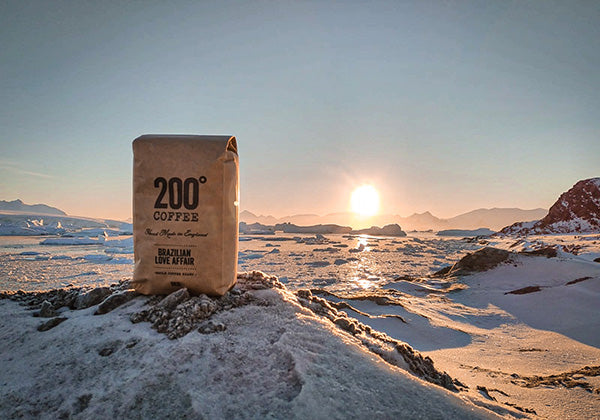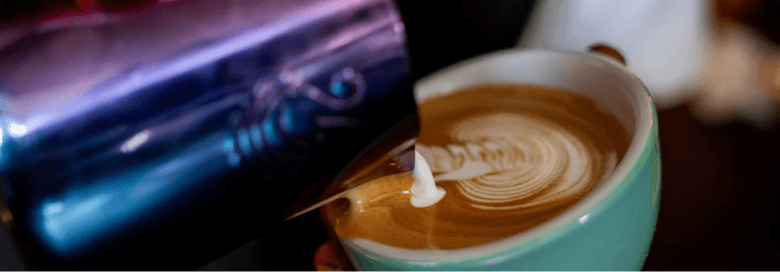200 Degrees visits the Antarctic

Our coffee does get everywhere, but this one is pretty exciting.
Imagine travelling 10,200 miles away to the depths of the Antarctic and discovering they serve your favourite 200 Degrees coffee.
We had the pleasure of connecting with one of the lead engineers from the British Antarctic Survey research station, who has spent the last three months drinking our coffee in one of the very few places in the world untouched by COVID!!
Tell us a bit more about where you’ve been for the last few months?
I’ve just returned from a research station called Rothera, located in Antarctica. The Station is situated on Adelaide Island, Antarctic Peninsular and is one of four year-round research stations operated by the British Antarctic Survey (BAS). My role while “south” was as the lead mast engineer. Due to the remote location, nothing is hard-wired as such. Therefore all communications are via satellite and a multitude of antenna systems, all of which are supported on masts.
Along with the vital communications Antennas used to speak to scientific parties undertaking field operations, there are also numerous scientific antenna systems used to conduct various research activities. These masts had to be climbed, inspected and serviced to ensure that they remain operational and rectify any issues the harsh environment may have caused, such as replacing sections of masts if they become damaged. Luckily for me, that means climbing nice and high, allowing me to have the best view on the island!
Among the conduction of Research in and around the Station itself, Rothera is a staging area for “field operations” in the region. In a busy season, there would be all kinds of scientists on Station, conducting many varieties of experiments such as tracking ice shifts on nearby ice shelves, taking core samples of ice deep beneath the surface, tracking migration patterns of wildlife such as the penguins or seals. Some other, more specific projects such as water sampling for microplastics or just sampling the water at various depths to measure water temps and other tests that an actual scientist would be able to tell you all about. Rothera also conducts diving operations and is one of the few places that conduct dives all year long, through the winter period. In the winter, they swap the boats used for chainsaws to cut a hole in the ice that covers the sea.
One of the activities people can enjoy when the working day is over is a walk “around the point”. The island has fantastic views when the weather allows; however, even when the visibility is low, there is always plenty of wildlife around to fill up space on your camera. There are numerous birds, including the SKUA, which nest on the island. These are large birds of prey, and if you find yourself too close to one, they will certainly let you know by dive-bombing. Pods of Orca can be seen to the south of the Station, and if you’re unlucky and don’t manage to see Orca, you’re more likely to see Minky or Humpback whales! There are more than a few species of seal that visit the island in the summer months, with Weddell seals being the most abundant whilst walking around the point. Similar to Weddell, we also have crab-eater seals.
You could also see a leopard seal; however, the marine team will not be happy as Dive operations cannot start or continue if a leopard seal is spotted in the area due to the increased risk to the dive team. One of the duties that anyone could be asked to conduct is known as seal watch. This usually lasts for around 30 mins before any planned dive activities, where a small team of spotters would scan the surrounding area for Orca and Leopard seals. Continuing with the varieties of seal that visit the island brings us to the elephant seal. These are huge and rotund animals who are relatively slow movers and smell particularly bad! They can often be seen in small groups, huddled together, sleeping, burping and can often cause a nuisance by blocking pathways. Lastly and certainly not least is the fur seal. These guys look like sea lions and move similar to them on land. They can be quite boisterous, and if you get too close for their liking, they have been known to chase people! They have some vast teeth that you wouldn’t want a bite from, that’s for sure! Later in the summer season, around the end of February through March, hundreds of seals descend upon the island and walking around the point becomes a game of dodging wildlife. Everyone who visits/works at Rothera is told to keep 5m from any wildlife to ensure our presence doesn’t affect the wildlife. There are times that this might be broken due to wildlife coming to you, for instance, or if there are animals in the location where you need to conduct work.
Moving on from the various whales, birds and seals, are the penguins! Everyone seems to love penguins, and after seeing them truly in the wild, I see exactly why! 95% of the penguins you will encounter whilst at Rothera will be Adelie penguins with the chance to see chinstraps or the odd sighting of an Emperor penguin! Adelie’s are very hardy penguins and very inquisitive! It’s quite common to take a seat and enjoy the views whilst walking around the point, only to find a penguin or two approaches you, basically to find out what/who you are. Apart from being interesting to see, it makes for a great photo if you don’t have a huge lens to zoom in with.
Did everyone on the base love our coffee?
So, there were around 120 on Station this season, so naturally, there will be a mix of people. Some tea drinkers, some people that don’t drink hot drinks (madness in my mind), people who will drink any coffee put in front of them and of course, those people who can appreciate good coffee! There were many people on Station that fall into the last bracket, and I can confidently say that the 200 Degrees coffee was a massive hit! So much so that the wintering doctor from last season (he’s just got back to the UK after spending around 18 months in Antarctica) had brought a LOT of coffee with him to keep him going as he, like me, was all about the coffee! Needless to say that when he had access to your coffee whilst “south”, he did not need to use the supply that he brought with him and was regretful that he had used so much of his allocated luggage space/capacity to bring so much coffee with him. So, in short, yes, everyone did love the 200 Degrees coffee.
Were you dealing with any COVID restrictions while you were there?
Actually, No, we were very fortunate to be pretty much the only place in the world that did not have any COVID restrictions. It wasn’t easy to get people there, though, and the extensive procedures and restrictions beforehand on us all meant that we were able to keep Rothera a completely COVID free place. A lot of the personnel on the Station travelled from the UK via ship. This ship was called the RRS (Royal Research Ship) James Clark Ross. The journey was around four to five weeks which immediately followed two weeks quarantine at a designated quarantine location where they would be regularly tested and monitored. Some other specialists like myself, who didn’t require as much time on Station to conduct their work, flew into the Falkland Islands and then isolated for two weeks before boarding a COVID secure and COVID free ship for a further five days to get us into the Research Station. Before we could fly to the Falkland Islands, we were all required to check and record our body temperature daily for the two weeks leading up to the flight.
How do you brew your coffee at home?
I actually brew my coffee in various ways at home, although I would say that using my V60 dripper is my go-to method. Depending on the coffee beans used, I will also determine if I have any milk too. Although the dripper is my go-to method, and if I’m honest, it’s because it’s the easiest to clean after, my favourite method is using my Aeropress. I have a Rhinowares ceramic burr hand grinder that fits inside the lid on the Aeropress, making it easy to travel with. There is something quite satisfying and scientific about grinding the coffee and measuring it out before using a specific amount of water, and timing the brew just right to get that “perfect” coffee. If I have a few friends round, I’ll throw some beans in the coffee machine to grind and make a pot of coffee for us to share and to fill the house with that unmistakable scent of freshly ground coffee! I’ve also got a few sizes of cafetiere and an espresso machine, although the latter rarely gets used these days.
So how did we end up supplying BAS? (by Tom V)
We were initially approached by BAS in 2018 to discuss how we could improve the coffee at Rothera, which was very poor. A member of their Logistics team came over to visit our Roast House in Nottingham to discuss their needs and the challenges of brewing in the Antarctic. After testing out some of the machines available, they tasked us to find the right set up that could work for them. The biggest consideration was reliability, as engineer call-outs would obvioulsy be impossible.
Our solution was two-fold. Firstly, a Bunn batch brewer for quick service at breakfast – a super reliable high volume machine that produces great fresh coffee for the same price as their old instant powder. As we can only ship the beans to them once or twice a year, we coupled this with a Bunn grinder so that they could grind the beans fresh every morning. The urns that this brews into are thermally insulated and could be taken out into the field with them - giving hot, freshly brewed coffee in sub-zero temperatures.
Secondly, we recommended two bean-to-cup machines for use in the breakout rooms to provide espresso based drinks on demand at the touch of the button. Our compromise here was that they had to use powdered milk, as cows are in short supply in the Antarctic. We programmed and commissioned the machines here in the UK and sent them out with a pack of wear-and-tear spare parts to enable simple maintenance to be done on-site throught the year.
Since our beans and machines have gone out to Rothera, we’ve had great feedback about the quality, and we are proud to have found a way of delivering great coffee to a dedicated team working in such a harsh environment.
